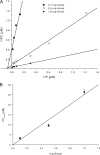Novel family of carbohydrate-binding modules revealed by the genome sequence of Spirochaeta thermophila DSM 6192
- PMID: 21685171
- PMCID: PMC3147429
- DOI: 10.1128/AEM.00523-11
Novel family of carbohydrate-binding modules revealed by the genome sequence of Spirochaeta thermophila DSM 6192
Abstract
Spirochaeta thermophila is a thermophilic, free-living, and cellulolytic anaerobe. The genome sequence data for this organism have revealed a high density of genes encoding enzymes from more than 30 glycoside hydrolase (GH) families and a noncellulosomal enzyme system for (hemi)cellulose degradation. Functional screening of a fosmid library whose inserts were mapped on the S. thermophila genome sequence allowed the functional annotation of numerous GH open reading frames (ORFs). Seven different GH ORFs from the S. thermophila DSM 6192 genome, all putative β-glycanase ORFs according to sequence similarity analysis, contained a highly conserved novel GH-associated module of unknown function at their C terminus. Four of these GH enzymes were experimentally verified as xylanase, β-glucanase, β-glucanase/carboxymethylcellulase (CMCase), and CMCase. Binding experiments performed with the recombinantly expressed and purified GH-associated module showed that it represents a new carbohydrate-binding module (CBM) that binds to microcrystalline cellulose and is highly specific for this substrate. In the course of this work, the new CBM type was only detected in Spirochaeta, but recently we found sequences with detectable similarity to the module in the draft genomes of Cytophaga fermentans and Mahella australiensis, both of which are phylogenetically very distant from S. thermophila and noncellulolytic, yet inhabit similar environments. This suggests a possibly broad distribution of the module in nature.
Figures



References
-
- Aksenova H., Rainey F., Janssen P., Zavarzin G., Morgan H. 1992. Spirochaeta thermophila sp. nov., an obligately anaerobic, polysaccharolytic, extremely thermophilic bacterium. Int. J. Syst. Bacteriol. 42:175–177
-
- Angelov A., Mientus M., Liebl S., Liebl W. 2009. A two-host fosmid system for functional screening of (meta)genomic libraries from extreme thermophiles. Syst. Appl. Microbiol. 32:177–185 - PubMed
-
- Bendtsen J. D., Nielsen H., von Heijne G., Brunak S. 2004. Improved prediction of signal peptides: SignalP 3.0. J. Mol. Biol. 340:783–795 - PubMed
-
- Boiangiu C. D., et al. 2005. Sodium ion pumps and hydrogen production in glutamate fermenting anaerobic bacteria. J. Mol. Microbiol. Biotechnol. 10:105–119 - PubMed
Publication types
MeSH terms
Substances
LinkOut - more resources
Full Text Sources
Molecular Biology Databases

